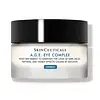What's inside
What's inside
 Key Ingredients
Key Ingredients

 Benefits
Benefits

 Concerns
Concerns

 Ingredients Side-by-side
Ingredients Side-by-side

Water
Skin ConditioningHydrogenated Polyisobutene
EmollientGlycerin
HumectantCera Microcristallina
Emulsion StabilisingDimethicone
EmollientUndecane
EmollientTridecane
PerfumingPEG/PPG-18/18 Dimethicone
EmulsifyingSilica
AbrasiveAlcohol Denat.
AntimicrobialTocopheryl Acetate
AntioxidantPolymethylsilsesquioxane
Ethylhexyl Palmitate
EmollientPhenoxyethanol
PreservativeLauryl PEG-9 Polydimethylsiloxyethyl Dimethicone
Skin ConditioningTocopherol
AntioxidantMagnesium Sulfate
Disteardimonium Hectorite
StabilisingGlucosamine Hcl
Tribehenin
EmollientCaprylyl Glycol
EmollientAllantoin
Skin ConditioningDisodium EDTA
Hydroxyethyl Urea
HumectantSorbitan Isostearate
EmulsifyingSodium Hyaluronate
HumectantFaex Extract
Skin ConditioningBiosaccharide Gum-1
HumectantPalmitoyl Oligopeptide
CleansingSilybum Marianum Extract
Skin ConditioningCeramide AP
Skin ConditioningWater, Hydrogenated Polyisobutene, Glycerin, Cera Microcristallina, Dimethicone, Undecane, Tridecane, PEG/PPG-18/18 Dimethicone, Silica, Alcohol Denat., Tocopheryl Acetate, Polymethylsilsesquioxane, Ethylhexyl Palmitate, Phenoxyethanol, Lauryl PEG-9 Polydimethylsiloxyethyl Dimethicone, Tocopherol, Magnesium Sulfate, Disteardimonium Hectorite, Glucosamine Hcl, Tribehenin, Caprylyl Glycol, Allantoin, Disodium EDTA, Hydroxyethyl Urea, Sorbitan Isostearate, Sodium Hyaluronate, Faex Extract, Biosaccharide Gum-1, Palmitoyl Oligopeptide, Silybum Marianum Extract, Ceramide AP
Water
Skin ConditioningGlycerin
HumectantDimethicone
EmollientIsohexadecane
EmollientParaffin
PerfumingPropylene Glycol
HumectantSilica
AbrasivePolyglyceryl-4 Isostearate
EmulsifyingCetyl PEG/PPG-10/1 Dimethicone
EmulsifyingHexyl Laurate
EmollientNylon-12
Hydroxypropyl Tetrahydropyrantriol
Skin ConditioningMethylsilanol/Silicate Crosspolymer
Skin ConditioningPolyethylene
AbrasiveAscorbyl Glucoside
AntioxidantCaprylic/Capric Triglyceride
MaskingOctyldodecanol
EmollientPhenoxyethanol
PreservativeTocopheryl Acetate
AntioxidantAmmonium Polyacryloyldimethyl Taurate
Emulsion StabilisingPEG-6 Isostearate
EmulsifyingTriethanolamine
BufferingSodium Citrate
BufferingMethylparaben
PreservativeChlorphenesin
AntimicrobialCaffeine
Skin ConditioningTitanium Dioxide
Cosmetic ColorantEthylparaben
PreservativeMenthoxypropanediol
MaskingVaccinium Myrtillus Fruit Extract
Skin ConditioningHesperidin Methyl Chalcone
AntioxidantPentasodium Pentetate
Aluminum Hydroxide
EmollientStearic Acid
CleansingHesperetin Laurate
AntioxidantN-Hydroxysuccinimide
Skin ConditioningDipeptide-2
Skin ConditioningPalmitoyl Tetrapeptide-7
Skin ConditioningPalmitoyl Oligopeptide
CleansingChrysin
Skin ConditioningWater, Glycerin, Dimethicone, Isohexadecane, Paraffin, Propylene Glycol, Silica, Polyglyceryl-4 Isostearate, Cetyl PEG/PPG-10/1 Dimethicone, Hexyl Laurate, Nylon-12, Hydroxypropyl Tetrahydropyrantriol, Methylsilanol/Silicate Crosspolymer, Polyethylene, Ascorbyl Glucoside, Caprylic/Capric Triglyceride, Octyldodecanol, Phenoxyethanol, Tocopheryl Acetate, Ammonium Polyacryloyldimethyl Taurate, PEG-6 Isostearate, Triethanolamine, Sodium Citrate, Methylparaben, Chlorphenesin, Caffeine, Titanium Dioxide, Ethylparaben, Menthoxypropanediol, Vaccinium Myrtillus Fruit Extract, Hesperidin Methyl Chalcone, Pentasodium Pentetate, Aluminum Hydroxide, Stearic Acid, Hesperetin Laurate, N-Hydroxysuccinimide, Dipeptide-2, Palmitoyl Tetrapeptide-7, Palmitoyl Oligopeptide, Chrysin
 Reviews
Reviews

Alternatives
Ingredients Explained
These ingredients are found in both products.
Ingredients higher up in an ingredient list are typically present in a larger amount.
Dimethicone is a type of synthetic silicone created from natural materials such as quartz.
What it does:
Dimethicone comes in different viscosities:
Depending on the viscosity, dimethicone has different properties.
Ingredients lists don't always show which type is used, so we recommend reaching out to the brand if you have questions about the viscosity.
This ingredient is unlikely to cause irritation because it does not get absorbed into skin. However, people with silicone allergies should be careful about using this ingredient.
Note: Dimethicone may contribute to pilling. This is because it is not oil or water soluble, so pilling may occur when layered with products. When mixed with heavy oils in a formula, the outcome is also quite greasy.
Learn more about DimethiconeGlycerin is already naturally found in your skin. It helps moisturize and protect your skin.
A study from 2016 found glycerin to be more effective as a humectant than AHAs and hyaluronic acid.
As a humectant, it helps the skin stay hydrated by pulling moisture to your skin. The low molecular weight of glycerin allows it to pull moisture into the deeper layers of your skin.
Hydrated skin improves your skin barrier; Your skin barrier helps protect against irritants and bacteria.
Glycerin has also been found to have antimicrobial and antiviral properties. Due to these properties, glycerin is often used in wound and burn treatments.
In cosmetics, glycerin is usually derived from plants such as soybean or palm. However, it can also be sourced from animals, such as tallow or animal fat.
This ingredient is organic, colorless, odorless, and non-toxic.
Glycerin is the name for this ingredient in American English. British English uses Glycerol/Glycerine.
Learn more about GlycerinPalmitoyl Oligopeptide is a form of peptide. It is created by blending peptides with palmitic acid. Peptides are building blocks for protein.
Due to the palmitic acid base, it may not be malassezia folliculitis safe.
This ingredients tells our body to create more collagen. Collagen is a protein that makes connective tissue. Boosting collagen production leads to a healthier skin barrier. Having a healthy skin barrier means having firm and hydrated skin.
Read more about other common types of peptides here:
Learn more about Palmitoyl OligopeptidePhenoxyethanol is a preservative that has germicide, antimicrobial, and aromatic properties. Studies show that phenoxyethanol can prevent microbial growth. By itself, it has a scent that is similar to that of a rose.
It's often used in formulations along with Caprylyl Glycol to preserve the shelf life of products.
Silica, also known as silicon dioxide, is a naturally occurring mineral. It is used as a fine, spherical, and porous powder in cosmetics.
Though it has exfoliant properties, the function of silica varies depending on the product.
The unique structure of silica enhances the spreadability and adds smoothness, making it a great texture enhancer.
It is also used as an active carrier, emulsifier, and mattifier due to its ability to absorb excess oil.
In some products, tiny microneedles called spicules are made from silica or hydrolyzed sponge. When you rub them in, they lightly polish away dead skin layers and enhance the penetration of active ingredients.
Learn more about SilicaTocopheryl Acetate is AKA Vitamin E. It is an antioxidant and protects your skin from free radicals. Free radicals damage the skin by breaking down collagen.
One study found using Tocopheryl Acetate with Vitamin C decreased the number of sunburned cells.
Tocopheryl Acetate is commonly found in both skincare and dietary supplements.
Learn more about Tocopheryl AcetateWater. It's the most common cosmetic ingredient of all. You'll usually see it at the top of ingredient lists, meaning that it makes up the largest part of the product.
So why is it so popular? Water most often acts as a solvent - this means that it helps dissolve other ingredients into the formulation.
You'll also recognize water as that liquid we all need to stay alive. If you see this, drink a glass of water. Stay hydrated!
Learn more about Water